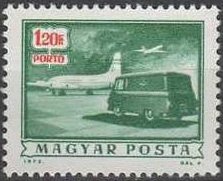Stamp: Postage due - Mail plane and truck (Hungary 1973)
Postage due - Mail plane and truck (Hungary 1973)
29 December (Hungary ) within release Postage Due goes into circulation Stamp Postage due - Mail plane and truck face value 1.20 Hungarian forint
| Stamp Postage due - Mail plane and truck in catalogues | |
|---|---|
| Michel: | Mi:HU P246 |
| Stamp Number: | Sn:HU J270 |
Stamp is horizontal format.
Also in the issue Postage Due:
- Stamp - Postage due - Money order cancelling machine face value 20;
- Stamp - Postage due - Scales in self-service P.O. face value 40;
- Stamp - Postage due - Automat for registering parcels face value 80;
- Stamp - Postage due - Keypunch operator face value 1;
- Stamp - Postage due - Mail plane and truck face value 1.20;
- Stamp - Postage due - Diesel mail train face value 2;
- Stamp - Postage due - Postman on motorcycle face value 3;
- Stamp - Postage due - Rural mail delivery face value 4;
Stamp Postage due - Mail plane and truck it reflects the thematic directions:
A vehicle (from Latin: vehiculum) is a mobile machine that transports people or cargo. Typical vehicles include wagons, bicycles, motor vehicles (motorcycles, trucks, buses), railed vehicles (trains, trams), watercraft (ships, boats), aircraft and spacecraft. Land vehicles are classified broadly by what is used to apply steering and drive forces against the ground: wheeled, tracked, railed or skied. ISO 3833-1977 is the standard, also internationally used in legislation, for road vehicles types, terms and definitions.
The mail or post is a system for physically transporting documents and other small packages; or, the postcards, letters, and parcels themselves. A postal service can be private or public, though many governments place restrictions on private systems. Since the mid-19th century national postal systems have generally been established as government monopolies with a fee on the article prepaid. Proof of payment is often in the form of adhesive postage stamps, but postage meters are also used for bulk mailing. Modern private postal systems are typically distinguished from national postal agencies by the names "courier" or "delivery service". Postal authorities often have functions other than transporting letters. In some countries, a postal, telegraph and telephone (PTT) service oversees the postal system, in addition to telephone and telegraph systems. Some countries' postal systems allow for savings accounts and handle applications for passports.
A car is a wheeled, self-powered motor vehicle used for transportation and a product of the automotive industry. Most definitions of the term specify that cars are designed to run primarily on roads, to have seating for one to eight people, to typically have four wheels with tyres, and to be constructed principally for the transport of people rather than goods. The year 1886 is regarded as the birth year of the modern car. In that year, German inventor Karl Benz built the Benz Patent-Motorwagen. Cars did not become widely available until the early 20th century. One of the first cars that was accessible to the masses was the 1908 Model T, an American car manufactured by the Ford Motor Company. Cars were rapidly adopted in the United States of America, where they replaced animal-drawn carriages and carts, but took much longer to be accepted in Western Europe and other parts of the world.
An aircraft is a machine that is able to fly by gaining support from the air. It counters the force of gravity by using either static lift or by using the dynamic lift of an airfoil, or in a few cases the downward thrust from jet engines. The human activity that surrounds aircraft is called aviation. Crewed aircraft are flown by an onboard pilot, but unmanned aerial vehicles may be remotely controlled or self-controlled by onboard computers. Aircraft may be classified by different criteria, such as lift type, aircraft propulsion, usage and others.




